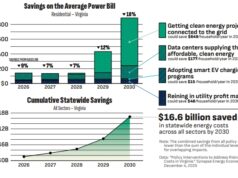By Will Driscoll, cross posted from Power for the People VA
Virginia could produce 32 percent of its electricity from rooftop solar installations, according to a report from the National Renewable Energy Laboratory (NREL). Yes, that’s a lot:
- It’s 28,500 megawatts of solar capacity—almost double the 15,000 megawatts that Dominion Virginia Power found would save customers $1.5 billion, but said it wouldn’t know where to site the solar panels.
- Installing that much rooftop solar in Virginia would yield about 50,000 jobs for ten years, based on the number of U.S. solar jobs in 2016 and the number of megawatts of solar installed.
 |
| Al Chiriboga and Andrew Schultz of Convert Solar install a 10 kilowatt solar system on an office building in Virginia Beach. |
The NREL analysis evaluated the potential for solar on buildings with at least one unshaded roof plane that is nearly flat, or faces east, southeast, south, southwest, or west. If any such roof plane could accommodate at least 1.5 kilowatts of solar panels, NREL modeled solar on that roof plane. Summing across all buildings in Virginia yielded a technical potential of 28,500 megawatts of rooftop solar. NREL found that nationwide, 66 percent of large building rooftop area is suitable for solar, versus 49 percent for medium-size buildings and 26 percent for small buildings.
The technical potential is simply what the laws of physics allow, combined with common sense—i.e., no north-facing panels. (NREL did count west-facing panels, which have value for meeting late afternoon electricity demand, and east-facing panels, which are equally productive.) NREL assumed an average solar panel efficiency of 16 percent, and noted that if panels averaging 20 percent efficiency were used, the solar potential would be 25 percent greater (because 20 is that much greater than 16). At least three firms make solar panels exceeding 20 percent efficiency.
The technical potential is just a theoretical maximum. Yet the economic potential, or the sum of all money-saving rooftop solar investments, may not be far behind, especially over the next ten years, as solar costs keep falling due to technology improvements and economies of scale. Each year more building owners realize they can save money with rooftop solar, including Virginia school systems.
 |
| Ryan Phaup and Andrew Harrison of Shockoe Solar install photovoltaic panels in Urbanna, VA. |
The Solar Foundation counted 260,077 U.S. solar workers in 2016, and the Solar Energy Industries Association reported 2016 U.S. solar installations of 14,626 megawatts. Dividing the two yields 18 workers per megawatt of solar installed. Finally, spacing out the installation of NREL’s 28,500 megawatts of Virginia rooftop solar over ten years would mean 2,850 megawatts of rooftop solar installed per year, times 18 workers per megawatt, or 50,000 workers—for a ten-year period.
For rooftop installations, the jobs per megawatt would tend to exceed 18, since rooftop jobs are smaller and more labor-intensive than the 2016 U.S. mix of utility-scale solar (10,000 megawatts) and rooftop solar. That is the experience of Edge Energy, whose co-owner Anthony Colella reports that installing one megawatt of solar per year requires a staff of 20—a roofing crew, an electrical crew, a project manager, a production manager, and sales and administrative support staff. He sees a growing solar potential in Virginia, and says his firm plans to add 15-20 staff members this year and a similar number in 2018.
On the other hand, as the rooftop solar industry grows to meet the NREL potential, economies of scale should also come into play, enabling firms to sell and install more panels in less time. So on balance, 18 jobs per megawatt, and 50,000 jobs over ten years, seems like a good ballpark estimate.
 |
| Henry Portillo (peak), Tulio Guzman and Carlos Cardona of Edge Energy celebrate an 8 kilowatt solar installation in Arlington, VA. |
The NREL report noted that “In practice, the integration of a significant quantity of rooftop solar into the national portfolio of generation capacity would require a flexible grid, supporting infrastructure, and a suite of enabling technologies.”
Mr. Colella of Edge Energy said that “to reach for the big numbers,” Virginia needs to lift the size limits on residential and commercial systems; eliminate demand charges on larger systems; change the voluntary renewable portfolio standard into a requirement, with a closed Virginia market for solar renewable energy credits; and allow solar leases, solar power purchase agreements, and community solar.
In response to the NREL projection, a Dominion Virginia Power representative stated that the utility is installing solar toward a state goal of 500 megawatts of solar by 2020. Appalachian Electric Power declined to comment.
Virginia currently has 238 megawatts of solar capacity, compared to North Carolina, which has 3,012 megawatts.















